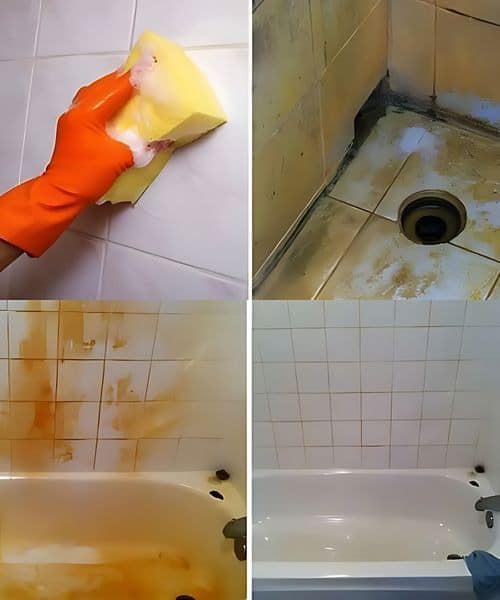ADVERTISEMENT
3. Let the Paste Sit
Let the baking soda paste sit on the tiles for 5 to 10 minutes. This gives the paste time to penetrate the soap scum and water stains, loosening them for easy removal.
4. Spray Vinegar on the Tiles
While the baking soda paste is working its magic, take your white vinegar and pour it into a spray bottle. Spray the vinegar over the areas where you’ve applied the baking soda paste.
- As soon as the vinegar hits the baking soda, it will fizz and bubble. This fizzing action helps break down the soap scum and mineral deposits on your tiles.
- Allow the vinegar and baking soda to react for a few minutes. You should start to see the buildup lifting off the surface.
5. Scrub the Tiles
After the fizzing action has slowed, grab your scrub brush or sponge and start scrubbing the tiles gently in a circular motion.
- Focus on problem areas, such as corners and grout lines, where soap scum and water stains tend to accumulate the most.
- For stubborn spots, you may need to apply a little extra pressure or reapply more paste and vinegar.
6. Rinse and Wipe Down
Once you’ve scrubbed the entire surface, it’s time to rinse. Use warm water to rinse off the baking soda and vinegar mixture. Wipe down the tiles with a microfiber cloth to remove any excess residue and leave the tiles looking spotless.
7. Dry and Polish
After rinsing, dry the tiles using a clean towel or cloth. This will help prevent water stains from forming as the tiles dry. Use a microfiber cloth to polish the surface, restoring the shine to your bathroom tiles.
Additional Tips for Dealing with Stubborn Soap Scum and Water Stains
While the baking soda and vinegar method is highly effective, there are a few additional tips you can follow to prevent future buildup and ensure your tiles stay clean:
- Use a Squeegee After Every Shower: To prevent soap scum and water stains from building up in the first place, make a habit of using a squeegee on your bathroom tiles after every shower. This will help remove excess water and soap before it has a chance to leave deposits.
- Install a Water Softener: Hard water is one of the main culprits behind water stains. If your area has hard water, consider installing a water softener in your home. This will reduce the minerals in the water, helping prevent the formation of stains on your tiles and glass.
- Regularly Clean Your Bathroom Tiles: To keep your bathroom tiles looking their best, try to clean them regularly. Weekly cleanings will prevent soap scum from building up and make deep cleaning much easier.
- Consider Using a Daily Shower Cleaner: If you want to maintain a soap scum-free shower, consider using a daily shower cleaner. Many products are available that are designed to prevent buildup and keep your tiles clean with minimal effort.
- Grout Cleaning: If your grout has become discolored with soap scum or water stains, try using the same baking soda and vinegar solution, or you can apply hydrogen peroxide directly to the grout lines for a deeper clean.
Conclusion
Cleaning bathroom tiles from soap scum and water stains doesn’t have to be a difficult or expensive task. By using a simple combination of baking soda and white vinegar, you can effectively eliminate these common bathroom issues and restore the shine to your tiles. The bubbling action from the vinegar and baking soda helps break down the stubborn buildup, while the gentle abrasiveness of baking soda ensures that your tiles remain unharmed.
With just a few minutes of effort, your bathroom tiles will look brand new, and your entire space will feel fresher and cleaner. By incorporating this cleaning routine into your regular maintenance, you can keep your bathroom sparkling without relying on harsh chemicals. So, pull out that baking soda and vinegar—you’re ready to tackle soap scum and water stains with ease!
ADVERTISEMENT
